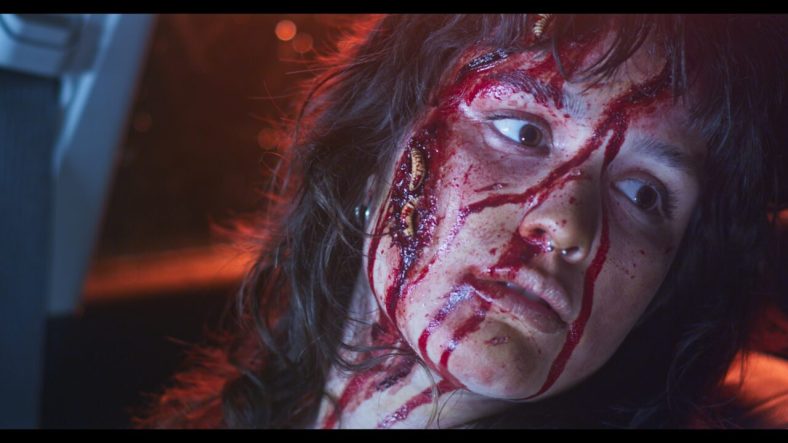
For trans filmmaker Alice Maio Mackay, the horror genre is her macabre playground, a way to craft creepy stories that expose the real-life threats of transphobia, queerphobia, and the limitations of living in a straight cis-hetero perspective while also having a bloody good time. Her latest feature film Carnage for Christmas is no different in this regard. But this time, expect some jolly good tidings dashed into a gore-filled small-town caper. Directed by Mackay, co-written by Mackay and Benjamin Pahl Robinson, and edited by The People’s Joker’s Vera Drew, Carnage for Christmas feels like the badass love child of Black Christmas, Nancy Drew, and the ‘90s grittier psychological thrillers.
Having its world premiere at 2024’s Salem Horror Fest, Mackay’s film spotlights her range as an artist deepening their worldbuilding sensibilities while continuing to put queer and trans characters front and center in films that platform the life-saving power of finding queer communities with punk aesthetics.
Read the full synopsis below:
When true-crime podcaster and sleuth Lola visits her hometown at Christmas for the first time since running away and transitioning, the vengeful ghost of a historical murderer and urban legend seemingly arises to kill again. Lola must solve the case before her community is slaughtered. She’s up against not only a psychotic killer, but a town haunted by secrets.
Dread Central spoke with Mackay about the film’s killer set pieces, its use of animation, and how what’s dreamt up here might just lay the groundwork for an entirely new queer horror television series.
Dread Central: A lot of the time when people are discussing your work, they’ll mention your young age. While I understand how an artist’s craft matures with their experiences, I think it’s also a bit unfair to frame critiques in that way, as if with a certain age, you’ll hit some sort of magical benchmark of filmmaking. So, I’d love to know what elements in your work feel specifically tied to the perspective of your youth and age group that seem to either go overlooked or perhaps misunderstood by older critics that you’re extremely proud of displaying.
AMM: I don’t really think there are elements in my films that are tied to my age that go overlooked, but perhaps more misunderstood by some critics, in the same way that some misunderstand elements that come from my perspective on transness. I think what I’ve noticed especially in the horror genre, is that some mainly male critics and audiences find it hard when a film doesn’t cater to their tastes and sensibilities or what their particular definition of a horror film is. Historically looking at films, like The Craft Legacy, Bit, or horror films that are aimed towards younger perspectives and queer communities, the backlash just for those films existing is crazy.
That being said, there are so many amazing supportive people, including critics, in the horror community who I love and admire, who I wouldn’t be here without, and who champion my work that I am forever grateful to.
DC: Of all your horror films, this one has the most detailed gore. It reminds me a lot of the kind of murdery mayhem we saw in 1995’s Seven. What inspirations did you look towards for how to design the killer (literally) set pieces in Carnage for Christmas? What was that process like between you and makeup designer Adele Shearwin?
AMM: My inspiration for the gore in Carnage for Christmas was definitely taken from Rob Zombie’s work. I think because the violence or gore is more sporadic in this film and its focus is more on melodrama, and crime solving, when there were kills or things of that nature, I wanted it to hit hard, and be as intense and gnarly as possible. Ben and I wrote pretty specific descriptions in the script, and Adele is just a genius who was able to take what’s on the page and bring that fucked up vision to life with almost no money.
DC: Without spoiling anything, there are really only two set-piece kills that the camera lingers on for more than a couple of frames. How do you choose when it makes sense to linger on the violence in a scene or speed it up for the viewer? I’m sure budgets have a lot to do with this but stylistically, it also seems like lingering in the aftermath of kills doesn’t interest you as much.
AMM: For me, it’s not so much budget constraints, but more stylistic preference. Without spoiling it there’s that one kill/set piece that was always going to be the biggest in Carnage for Christmas and one that the camera lingers on more, for a few reasons. It’s the most detailed kill and also the most intense. For me, it also made sense for the camera to linger on it as compared to a basic kill or whatnot, it’s showing the extent of how fucked up the murderer is.
DC: I was so surprised and thrilled when the beginning of this movie gifts us with a dynamic animation sequence. The pacing, the close-ups, the sliding transitions, it all works so well here! What was it like for you to use this sequence as a way to display a backstory? Did it make you want to play with this technique more in future films or even help create an entirely animated film?
AMM: Thank you so much! I love animation and it was really the only way I could see this sequence and backstory of working out., given how it deals with pre-transition and younger versions of the characters. I don’t want to say too much but there’s definitely something more animation-centred in the works!
DC: I love that the framework of this story is centered around a small town’s urban legend—a favorite subgenre of mine! When designing the Toymaker’s urban legend, at which point were you like, “Oh, this definitely has to be a holiday-themed urban legend?” What constraints did you want to put around that?
AMM: From the beginning of writing Carnage for Christmas with Ben, we knew it was going to be a holiday-themed urban legend. It was a subgenre we both loved and hadn’t explored before. In terms of legends and hauntings, we looked at works of R.L. Stine and classic murder mystery shows as inspiration. There weren’t really constraints put in place, but more that we had to fully commit to the Christmas and holiday setting, all the way from script to costume design where Lola is wearing Christmas bow earrings.
DC: After filming a holiday horror film, what’s one thing you wished you knew ahead of time that you’d like to share with young filmmakers?
AMM: I think it’s just like making any other film, but to make sure everyone is on the same page in terms of the setting. As I mentioned previously from lighting, to costume to the script, our whole team was committed to the setting a thousand percent and hopefully, that reads on-screen.
7. I won’t spoil the ending here, but the way the film wraps up, it almost felt like it was setting up a miniseries. You could 100% see this grow into a format with a case-by-case structure to dive more into this world. Would you have any interest in exploring that? Or do you feel like this was a joyous one-and-done situation? Lola is just so freaking cool and rebellious that I’d love to see her again!
AMM: Oh, 1000 percent! I’m so glad you think that, thank you! From the start, even to the length of the film itself, it’s a homage to the 1977 Hardy Boys/Nancy Drew television series and Columbo. I would love to return to these characters and this world.
DC: Let’s tease a little bit about the killer here. Slashers are known for giving their killers a unique visual representation and yours has a very creepy mask. What led you to decide on using this particular one for the killer and why?
AMM: Definitely, I mean from my perspective I don’t think I’d classify this as a slasher film but having the killer be as creepy as possible was always the end goal. That really comes down to my beyond-incredible costume and production team. We wanted to have it kind of tie in/relate to the toymaker origin that’s mentioned as much as possible. But from the description Ben and I wrote, we let the team take charge.
DC: If you could program a double feature with Carnage for Christmas and another holiday slasher, which one would it be?
AMM: I would actually double it with the Nancy Drew Pamela Sue Martin 1981 Holiday Special, which is a burglar Santa-type story. But if I had to keep it more in the horror genre, my second choice would be any of the Black Christmas films including the divisive remakes.
Categorized:Interviews


